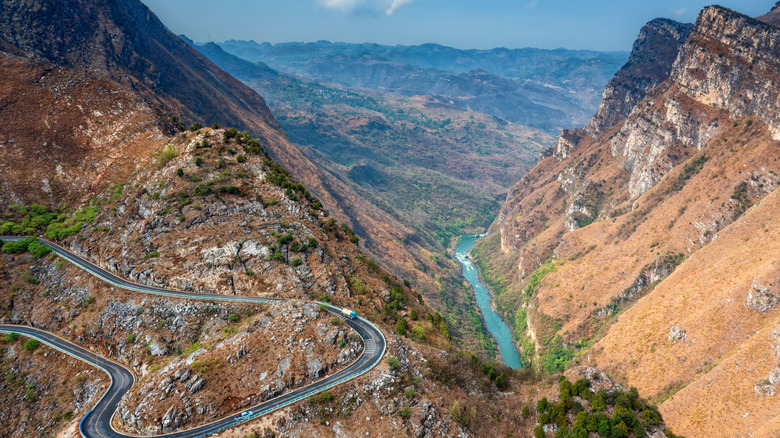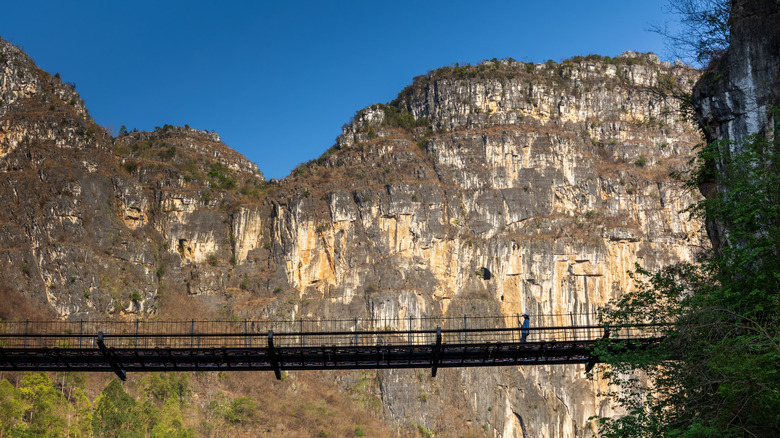China's New Record-Breaking Bridge Is More Than Just A Canyon Crossing
On September 28, 2025, China unveiled the Huajiang Grand Canyon Bridge in Guizhou Province, claiming the title of the tallest bridge in the world. Its deck soars roughly 2,050 feet above the Beipan River — twice the height of the Eiffel Tower and far above the previous record-holder, the Duge Bridge at 1,854 feet. Stretching just under 1.8 miles with a main span of 4,659 feet, it also claims the mantle of the largest-span bridge built in a mountainous region.
Beyond its dizzying height, the bridge's scale and swift construction attracted attention. Built in just under four years, the project deployed advanced prefabrication, drones, sensor networks, and real-time structural monitoring to guarantee safety. As a final test, engineers drove 96 trucks across high-stress sections over several days, simulating live traffic and measuring deflection and vibration.
China is no stranger to incredible feats of engineering. Take its iconic Great Wall, the Shiziguan Floating Bridge, or the thrilling Zhangjiajie Glass Bridge. The Huajiang structure signals that China continues to push the envelope of civil engineering. Yet the bridge is more than a record setter; it's a catalyst for dramatic change in a region long hindered by terrain.
Huajiang Bridge cuts travel time down to minutes
Before the bridge's construction, travelers crossing this section of Guizhou faced a grueling two-hour journey. Now, the trip shrinks to roughly two minutes on the new expressway. This shift is more than time saved — it's a powerful economic lever.
Guizhou, historically one of China's poorest and most mountainous provinces, has long suffered from geographic isolation. Fortunately, the bridge connects the Liuzhi Special District and Anlong County via the S57 Liuzhi-Anlong Expressway. This speeds up the transportation of goods, boosts trade, and makes access to markets and services more feasible for villagers. Local and provincial officials expect a significant uplift in regional employment and investment in the coming years.
The bridge is also integrated with tourism and recreation plans. Cliffside walkways, a sky café, observation decks, and even a high-altitude bungee jumping platform will be deployed to draw visitors. Planners envision it as a destination unto itself — part infrastructure, part attraction.
Engineering, ambition, and a broader narrative
Even in China, where grand bridges are common, Huajiang stands apart for its combination of height, span, speed of build, and ambition. Its construction employed over 21 patented innovations, an intelligent cable hoisting system, 2,000 MPa high-strength steel wire, and integrated sensor networks to monitor displacement, tension, and wind vibration in real time. Yet the bridge's symbolism may be its greatest impact. It tells a story of transformation: in challenging terrain once deemed unreachable, China marshals resources, design, and political will to bend geography.
For Americans accustomed to grand infrastructure — think the Hoover Dam, our Interstate System, or the Golden Gate — the comparison is instructive. Huajiang is not just a bridge: It's a statement of how modern countries view connectivity, control, and ambition. Still, the project carries risks. Environmental disruption in fragile mountain ecosystems, cost overrun potential, and long-term maintenance at such an altitude are real challenges. The lofty towers, expert instrumentation, and bold spans are only as good as their upkeep. But if it works — and many expect it to — this canyon crossing may serve as a model for other remote areas worldwide.
In the end, the Huajiang Grand Canyon Bridge is much more than a canyon crossing. It is a triumph of engineering, a spur to regional development, and a bold marker of how infrastructure can reshape landscapes and opportunity. You might be interested in other amazing bridges around the world.


